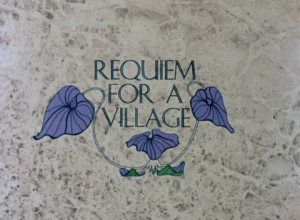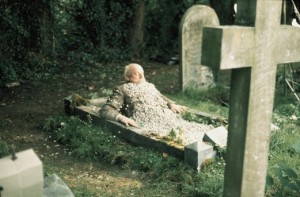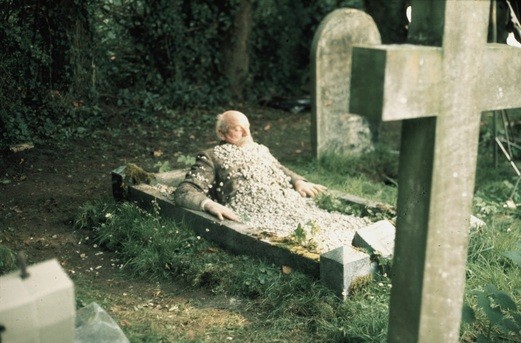 (1975, dir. David Gladwell)
(1975, dir. David Gladwell)
LOCATION: Suffolk
Words: Gareth E Rees

Requiem for a Village opens with a shot of a new-build housing development in Suffolk, 1975.
An old man emerges from one of the houses with his bike and wobbles onto a dual carriageway teeming with traffic. He rides to a church in the village threatened by machines of progress. Giant excavators loom over the hedgerows. As the old man works, the Victorian dead rise up from their graves and enter the church to attend a wedding.
From here, the film weaves an imagined past into the present. The grave-tender hallucinates a scene of hand-threshing, farmhands swinging their scythes to valedictory trumpets in golden fields.
But the film refuses to wallow in an idealised past. The scene turns ugly as these same farmers rape a girl in the hay. This is inter-cut with a modern marital bedroom rape, and shots of a Wimpey Homes truck rumbling over the sod, taking the land by force.
In this unflinching film, modernity and the past co-exist. They challenge each other. Bleed into each other.
This is true of progress. It doesn’t move across the county in a single sweep, bringing everyone along with it. Time moves differently for people in different geographies.
In the real world, epochs overlap
In Britain today it is still possible to cycle through a world of pagan traditions, farms, worn holloways and thatched villages while – less than two hundred metres away – cars with sat navs speed down motorways.
But these parallel existences can’t remain separate for long. It’s only a matter of time.
The Suffolk villagers in Requiem seem like a lost Amazon tribe, bewildered and powerless as the forest is cut down around them, and a new world advances.
In a gesture brimming with pathos, the grave keeper throws a clump of earth at the wheel of a Wimpey digger and stares in fury across churned fields. Victorian ghosts, oblivious to the future, reunite in the graveyard, hugging each other with joy. Meanwhile, in 1975, a gang of bikers roars through a tarmacked estate.
Gladwell’s film illuminates how the mind can sustain a myriad geographies, spanning epochs. Our only fleeting hope of liberation is through the imagination.
Watch the trailer:

ABOUT THE AUTHOR
Gareth E. Rees is author of Unofficial Britain (Elliott & Thompson, 2020) Car Park Life (Influx Press 2019), The Stone Tide (Influx Press, 2018) and Marshland (Influx Press, 2013).








I already love this film, now i just need to watch it. Thank you.
Great review, but the film is set in Suffolk not Norfolk.
Hi Gavin – thanks for pointing that out. Corrected now!
Best wishes
Gareth